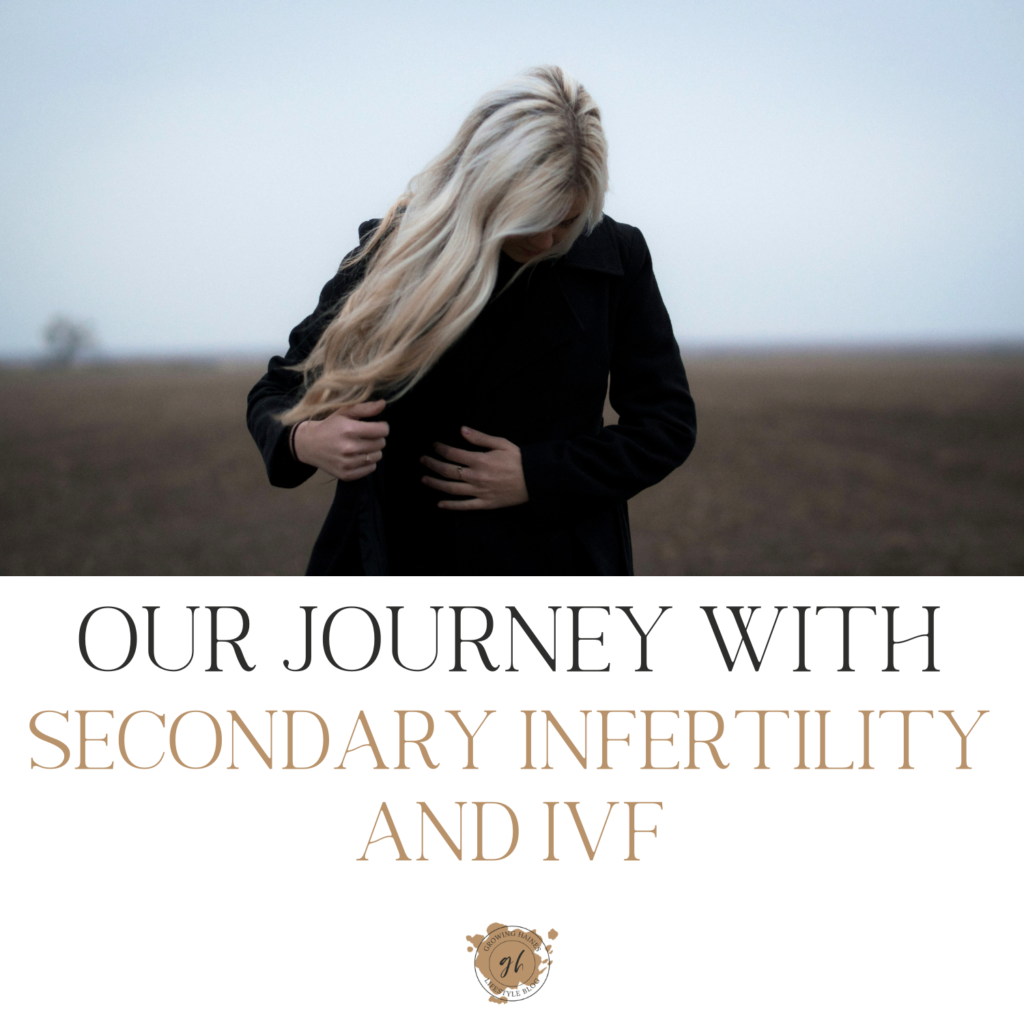This is a post I’ve meant to write for awhile but just haven’t known where to start. If you read this post in August, you know that we were expecting our second child this fall. I’m happy to say we welcomed our healthy baby boy in November to complete our family. So with that in mind, I felt now was a good time to share our story on dealing with secondary infertility and IVF.

The Road to My First Pregnancy & Delivery
When my husband and I decided we were ready to start our family, it didn’t take too long for us to get pregnant with Ivy. While I was mentally tracking ovulation, it never got to the point of using ovulation tests or needing any type of medical intervention. The pregnancy itself was pretty uneventful but due to some complications it was suggested by my doctor to get induced 5 days prior to my due date.
In short, I went in to be induced on a Monday evening around 7:30 p.m., where the labor and delivery team started the ripening of my cervix. The following morning, they broke my water and started me on Pitocin to induce contractions. It wasn’t until that evening, around 7 p.m., that I was dilated enough to start pushing, however, after roughly 2 hours without much progress, my doctor recommended we move to a c-section. For context, Ivy was sunny-side up and born with a head in the 99th percentile so she was essentially stuck in the birth canal. I was prepped for surgery and she was born just after 10 p.m.
Ivy’s Post-Birth Story
The c-section surgery itself went as planned – I was sore after, but what woman isn’t after a major abdominal surgery? However, about 2 weeks after delivery, I started feeling ill – feverish with flu-like symptoms. I saw my doctor on two separate occasions and at the second visit, they admitted me to the hospital. After various tests, it was determined that I had endometritis, which is an infection in the lining of the uterus. In order to help draw out the infection, my doctor had to reopen a small part of my c-section incision and use a dressing that needed to be changed multiple times a day. This treatment plan went on for weeks, with my husband changing the ribbon (or dressing) two to three times a day and weekly appointments with my doctor to check progress.
Determining Secondary Infertility by Way of an Ectopic Pregnancy
Getting pregnant a second time was proving much more difficult than it had been when trying for Ivy. We waited a couple of years after having Ivy to start trying again, and after about a year or so of trying naturally, we sought the help from my OBGYN in 2019. Blood tests for me were the starting point, and everything came back normal, as did testing for my husband. Next was an HSG, which is a procedure performed by my doctor to look at my fallopian tubes to ensure they’re clear. After that was a hysteroscopy, where my doctor went in and checked for scarring in the uterus and cleaned up what she could.
While none of those produced immediate results, I ended up getting pregnant naturally in January of 2021. However, around the 4.5 week mark I experienced severe pain in my right side that caused me to lay down in the fetal position for an hour or so until it subsided. After a visit to my doctor, and indicating the pain seemed to be getting better, they told me to return if it started again. Well days later, the pain was intense and another visit to the doctor confirmed my fears – my pregnancy was ectopic. An ectopic pregnancy is when the fertilized egg implants outside the uterus, usually on a fallopian tube, and can be life-threatening if not caught and treated.
I was sent to the hospital after an ultrasound confirmed the egg hadn’t implanted in my uterus to run some blood tests that my doctors office couldn’t turn our around in-house as quickly as was needed. The results of the blood test, which look at HCG levels, would determine the treatment plan – either an injection to stop the pregnancy from progressing or a laparoscopy surgery to remove the egg. Unfortunately, my HCG levels were too high for the injection to work so I was scheduled for an emergency surgery first thing the following morning.
By the next morning, my pain was so terrible I didn’t know if I’d make it to the surgery without first passing out on the waiting room floor. I was definitely scared as I knew if my fallopian tube ruptured, I could be in major trouble with internal bleeding.
I was put under anesthesia for the surgery, in which the doctor cut two one-inch openings on either side of my abdomen, allowing them to go in and remove the egg. And because of how the egg implanted, the doctor also removed my right fallopian tube.
At my follow-up appointment from the ectopic surgery, I was finally given some answers to why we struggled so much to get pregnant. While the doctor was removing the egg, and my right tube, she removed additional scar tissue around the area that she could get to with the instruments she was working with. She indicated the scarring on my left side was far worse – she couldn’t even find where my fallopian tube was because the scarring was so heavy. Her hypothesis was that this scarring was caused by the complications I experienced after having Ivy.
Based on what she saw during surgery, there were two options to think about if we wanted to pursue having another child. Option one was to do another surgery to try and go in and clean up the scar tissue around my remaining fallopian tube and try to conceive naturally. However, she mentioned there were risks of complications in that surgery that could cause me to end up losing my other remaining tube. She also mentioned that, while the chances were very slim, there was still a chance I could get pregnant naturally and the likelihood it would end in another ectopic was extremely high.
Option two was to pursue IVF (in-vitro fertilization). This was her recommendation since my uterus looked great so getting pregnant this route should be successful.
Moving Forward with IVF
While the answers to my fertility issues weren’t what I wanted to hear, it was a relief to finally have insight into why we were struggling to get pregnant again. I quickly set up a consultation with a doctor at one of the REI clinics to learn more about next steps for IVF, but was laid off from my job the day before the appointment. However, fast-forward a year and half later, we were ready to begin our IVF journey again. And thankfully this time around I work for a company that provides fertility insurance benefits to help with the cost.
I plan to do a full write-up on the steps I took from start to finish so I won’t go into too much detail here. I will say that going through IVF is definitely not for the faint of heart – it was hard and there were many times that I wanted to give up. My heart aches for women who have to go through the process multiple times – it takes so much out of you emotionally, mentally and physically.
I was so fortunate to have both my cousin (who’s been my lifelong BFF) and my sister-in-law working at my clinic. I truly don’t know if I could have stayed slightly sane through the whole journey without them. My cousin was my sonographer for a lot of my ultrasound appointments, and my sister-in-law was my dedicated nurse, who I had the most contact with throughout the 4-5 months it took from start to graduation (as my clinic called it).
Looking back, I think the transfer period was the hardest. Don’t get me wrong, all the medications and restrictions required for preparing for the egg retrieval wasn’t fun, but the mental and physical toll with the transfer medications were worse. And then that moved into having all-day morning sickness until around 18 weeks. It’s crazy the mental gymnastics I felt – pure exhilaration over being pregnant after going through so much but so miserable because of said pregnancy. But in the end, it’s all been worth it to welcome our little miracle man into our lives to complete our family.
In closing – if you’re struggling with infertility, I’m sending you the biggest virtual hug. I know all too well the feelings of discourage, anger and even resentment that you feel on a monthly basis. And I know not all stories end like mine. But if you have any questions on the IVF process or what I went through to get there, I’m a pretty open book and happy to chat.


